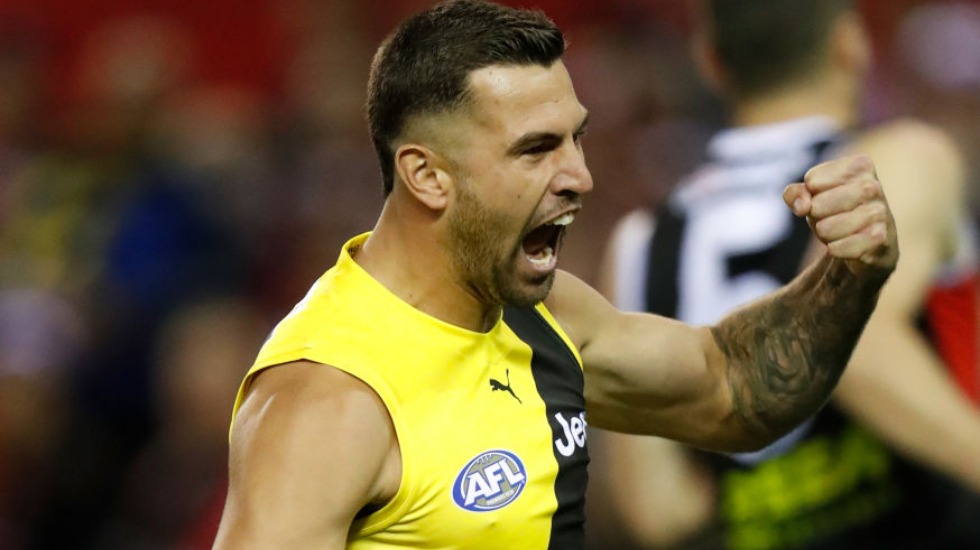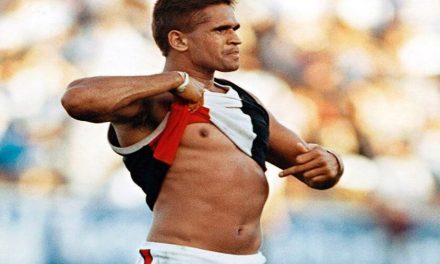Richmond’s Jack Graham is producing a career-defining campaign adding a different texture to a brilliant group. AFL MEDIA
Richmond is the AFL’s first empire to be powered by imagination
The world’s greatest artists are regularly able to shock and inspire their audience, re-imagine their industry and elevate a society’s senses. They’re also, invariably, tricky beasts that prove endlessly challenging to those trying to interpret their work.
These days, there’s no question that the Tigers are the AFL’s indisputable great artist. They’re also its most confounding.
You could ask 39 different footy people their views on what makes Richmond so incredible, and you may well receive 39 different responses. While a good smattering of Dustin Martin will likely feature, it’s Richmond’s lack of classification that makes it so devastatingly good. And so perplexing.
Hawthorn, the league’s previous all-conquering Goliath, was a little easier to pin down.
The Hawks were the AFL’s equivalent of FC Barcelona; a possession and territory-obsessed leviathan fuelled by some of the game’s greatest technicians the sport had ever collectively assembled.
From Luke Hodge to Shaun Burgoyne to Sam Mitchell, the Hawks were consistently able to call upon obscene skill to service footballing royalty in Lance Franklin and Jarryd Roughead up forward.
On the rare occasion the Hawks didn’t have the footy, the sport’s greatest-ever defensive forward in Cyril Rioli would appear in an opponent’s rearview mirror, and in their nightmares too.
The Tiger footprint isn’t as distinct.
There’s of course certain trademarks which highlight their art, such as a revolutionary approach to stoppages and perhaps the best counter-attack the AFL has ever seen, yet Richmond’s legacy has instead been principally constructed upon improvisation, adaptation and imagination.
And it’s these traits that not only set them apart and make them so profoundly unique, but threaten to grant them a more durable premiership window shelf-life than your more garden variety AFL behemoth.
Richmond’s lack of a defining identity positions it uncomfortably among the AFL’s previous legendary artists, and is perhaps why the footy world has been reluctant to embrace it as an all-time great. And so restless to write the Tigers’ obituary.
It’s why so many have been quick to get their hands on the Bulldogs frighteningly re-energised and reloaded album, and while so many are so keen to dance with the undefeated Demons. The spotlight remains bright light where Port Adelaide are concerned, while Geelong has just returned Patrick Dangerfield to lead vocals and will soon be able to add Jeremy Cameron’s blistering guitar to its sound as well.
Unlike previous footballing monoliths such as the early-millennium Lions, Geelong or indeed the Hawks, Richmond’s discography isn’t treated with the same reverence, which not only seems odd, but highly complacent.
PLEASE HELP US CONTINUE TO THRIVE BY BECOMING AN OFFICIAL FOOTYOLOGY PATRON. JUST CLICK THIS LINK.
Sure, while the Bulldogs and Melbourne have looked more menacing in the early stages of 2021, Richmond’s best songs aren’t usually found at the start of its albums anyway, while those who have tuned in so far have likely noticed some ominous new themes emerging from this constantly innovative force.
In last Thursday’s 86-point mauling of St Kilda, the Tigers not only produced an hellaciously sharp, and round-best 11.44 disposals per scoring shot, but it was an efficiency powered by a re-modified midfield set-up that actually dialled up its highest clearance differential (+16) in more than seven years.
Speaking of clearances, Richmond is actually ranked third this season for centre clearance differential with its +2.2 number easily the club’s best since it’s 2017 metamorphosis.
And this time round, it’s the likes of Shai Bolton and Jack Graham leading the way, with both producing career-defining campaigns that have added a completely different texture to a usually brilliant group.
While Bolton leads the Tigers for total clearances and ranks third for inside 50s, Graham is one of just three players in the league, along with Tom Liberatore and Andrew McGrath, averaging at least 19 disposals, five tackles and 25 pressure acts per game.
What makes Damien Hardwick such an exceptional coach, and the Tigers such an irrepressible force, is how incredibly diverse its talent is and how exceptionally multifaceted they are from a strategic point of view.
This is a club which refuses to be pigeon-holed into a defined style of game, and is obsessed with extracting every last drop of talent from its list.
It’s precisely why someone like Jayden Short has jumped off the club’s rookie list to become a best and fairest winner in a premiership year, and why he’s now regarded as one of the league’s most damaging defenders. It’s indeed why so much Tiger talent has risen from obscurity to become vital members of this all-conquering club.
At a time when the sport is changing so much, and where games are being influenced more than ever by whiteboards and from within the coaches box, Richmond’s absolute prioritisation of imagination provides it with a distinct advantage.
While art and imagination don’t sit comfortably with AFL traditionalists, Richmond is more than happy to be under-appreciated, and keep busy adding premierships to the trophy cabinet, while bending the sport in all manner of directions.
The Tigers have constructed the AFL’s first-ever dynasty built on imagination. It’s what makes them spectacularly weird, often misunderstood, but ultimately, endlessly inspiring.
You can read more of James Rosewarne’s work at STATS INSIDER











